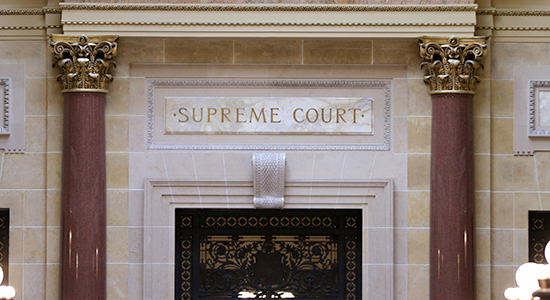
Jan. 20, 2017 – A man convicted for drunk driving challenged evidence obtained from a blood draw conducted by an Emergency Medical Technician (EMT) in jail. Recently, the state supreme court upheld the conviction, reversing a lower appeals court decision.
In 2013, police stopped Patrick Kozel’s vehicle in Sauk County after observing signs of erratic driving. Kozel exhibited signs of intoxication, including slurred speech and bloodshot eyes. The deputy also said Kozel was emitting a strong odor of intoxicants.
The deputy conducted a field sobriety test after learning that Kozel had a prior conviction for operating while intoxicated (OWI). Kozel failed. A preliminary breath test revealed a 0.17 blood alcohol concentration (BAC), well over the legal limit of 0.08.
The deputy arrested Kozel and transported him to jail, where Kozel agreed to a blood draw. An EMT performed the blood draw. The Wisconsin State Laboratory tested the samples, which showed a BAC of 0.196. Kozel was charged with OWI, second offense.
Kozel filed a motion to suppress evidence derived from the blood draw. He argued that the EMT did not have statutory authority to conduct the blood draw.
In drunk driving cases, blood draws are allowed under Wis. Stat. section 343.305(5)(b). But blood draws can only be conducted by persons “authorized to draw blood” or persons “acting under the direction of a physician.” Kozel argued that the EMT was not authorized to draw blood and was not a person acting under the direction of a physician.
He also argued that his blood was taken in a constitutionally unreasonable manner in violation of his Fourth Amendment right against unreasonable searches and seizures. Specifically, he argued that an EMT taking blood in a jail setting was unconstitutional.
The circuit court denied Kozel’s motions and he ultimately pled no contest to OWI, second offense. On appeal, the appeals court reversed the conviction and remanded the case with directions to suppress the evidence obtained from Kozel’s blood.
 Joe Forward, Saint Louis Univ. School of Law 2010, is a legal writer for the State Bar of Wisconsin, Madison. He can be reached by email or by phone at (608) 250-6161.
Joe Forward, Saint Louis Univ. School of Law 2010, is a legal writer for the State Bar of Wisconsin, Madison. He can be reached by email or by phone at (608) 250-6161.
The appeals court did not find sufficient evidence that the EMT conducted the blood draw under a physician’s direction. Thus, it did not reach the constitutional question.
In State v. Kozel, 2017 WI 3 (Jan. 12, 2017), the Wisconsin Supreme Court reversed the appeals court. A 5-2 majority concluded that the EMT was authorized to conduct the blood draw and the blood draw conducted did not violate the Fourth Amendment.
EMT was Authorized to Draw Blood
The majority, in an opinion by Justice Annette Ziegler, concluded that the EMT who drew Kozel’s blood was authorized to do so by a supervising physician.
The EMT worked as an intermediate technician for the Baraboo District Ambulance Service (BDAS). Dr. Manuel Mendoza, the medical director for BDAS, had authorized a standing order for EMTs with BDAS to draw blood at the request of law enforcement.
Kozel had argued that the EMT was not “acting under the direction of a physician” because Dr. Mendoza did not “direct” the EMT with respect to Kozel’s blood draw.
“The concept of ‘direction’ reasonably contemplates varying degrees of proximity between a director and the person whose actions he or she guides rather than a single, set relationship applicable in all cases,” Justice Ziegler wrote for the majority.
Justice Ziegler noted that Dr. Mendoza’s standing order pertained to EMTs who have obtained extensive training with regard to blood draws. In addition, she noted that the EMT could contact Dr. Mendoza by phone in the event problems arose.
“To require more evidence than what the State provided below to establish [the EMT] was acting under the direction of Dr. Mendoza would be to require a specific type or degree of direction where the statute at issue does not so specify,” Ziegler wrote.
Blood Draw did Not Violate Fourth Amendment
Blood draws must be conducted in a constitutionally reasonable “manner” under the Fourth Amendment, and Kozel had argued that his blood draw was not.
That is, he argued that medical risks are present when blood is drawn, so it was unconstitutional for an EMT, not a physician, to conduct the blood draw, especially when the blood draw occurred in a jail and not a medical setting.
“First, it was not unreasonable for an EMT, as opposed to a physician, to draw Kozel’s blood,” Justice Ziegler wrote. “The important point for constitutional purposes is that the evidence demonstrated that [the EMT] was thoroughly trained and experienced in properly drawing blood.”
“Second, it was not unreasonable for the blood draw to occur in the non-medical setting of the jail,” wrote Ziegler, noting evidence that Kozel’s blood draw occurred in a room that was just as clean as an emergency room and the EMT used a sterile needle.
Dissent
Justice Ann Walsh Bradley dissented, joined by Justice Shirley Abrahamson. They did not find sufficient evidence to determine “that the EMT-Intermediate technician who drew Kozel’s blood was a ‘person acting under the direction of a physician.’” The dissenters also concluded that the blood draw was not constitutionally reasonable.
“As the court of appeals in this case explained, evidence that an EMT was authorized to act under a physician’s license is not evidence that the EMT was acting under the physician’s direction,” Justice A.W. Bradley wrote. “In short, no evidence was presented of any supervision of this EMT by Dr. Mendoza, whether it be general or direct.”
Justice A.W. Bradley concluded that the blood draw was not constitutionally reasonable because the record did not include evidence that blood draws at this jail had protocols and procedures to ensure the safety and accuracy of blood draws performed there.
“Permitted blood draws in a jail without written protocols and procedures could erode Fourth Amendment protections,” wrote Justice A.W. Bradley.
She said the record did not indicate that Dr. Mendoza had ever been to the jail, let alone inspect it. And the state code only requires a monthly sanitation inspection for jails.
“[T]he blood draw here falls below the standard of anything that has previously been determined to be reasonable,” A.W. Bradley wrote.
